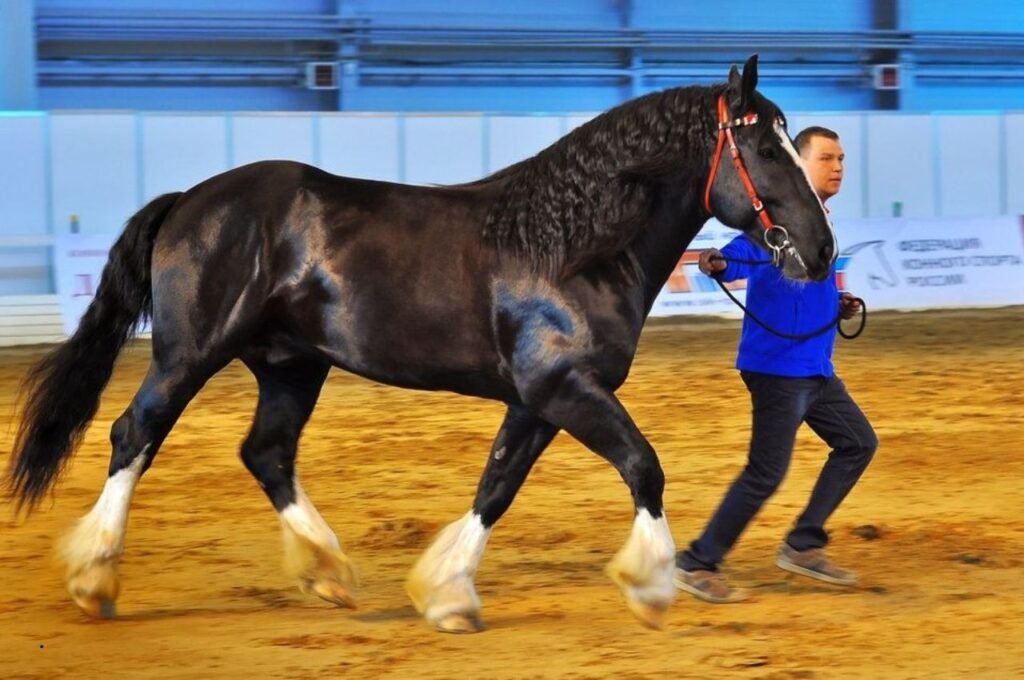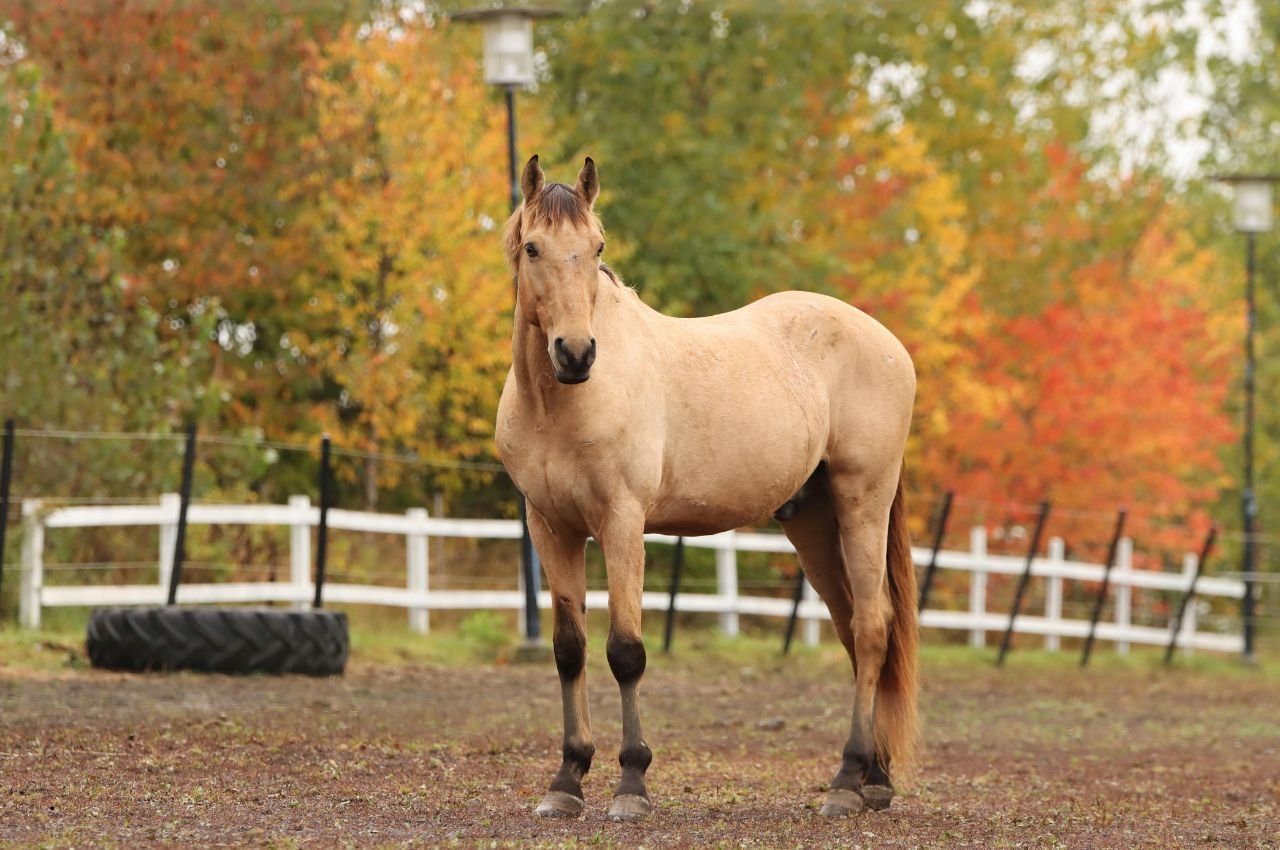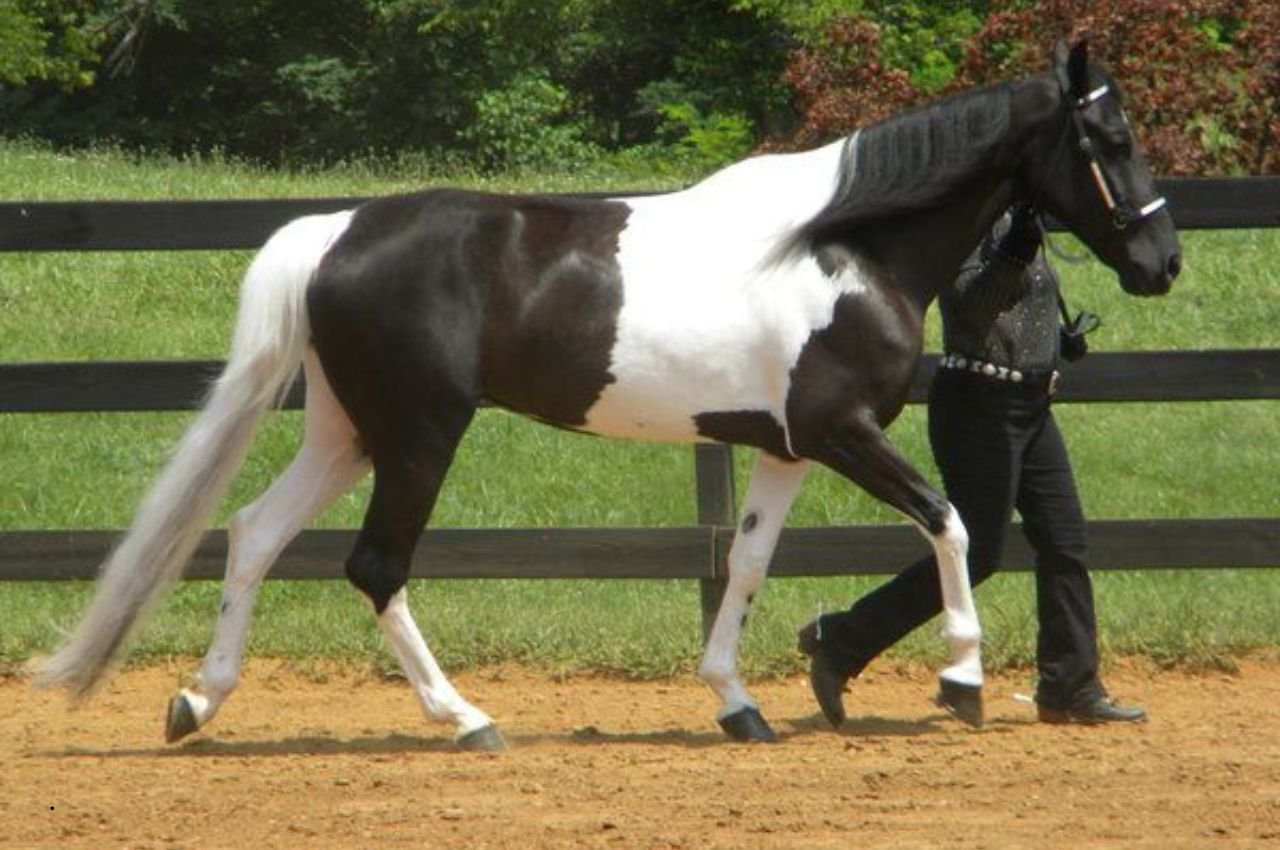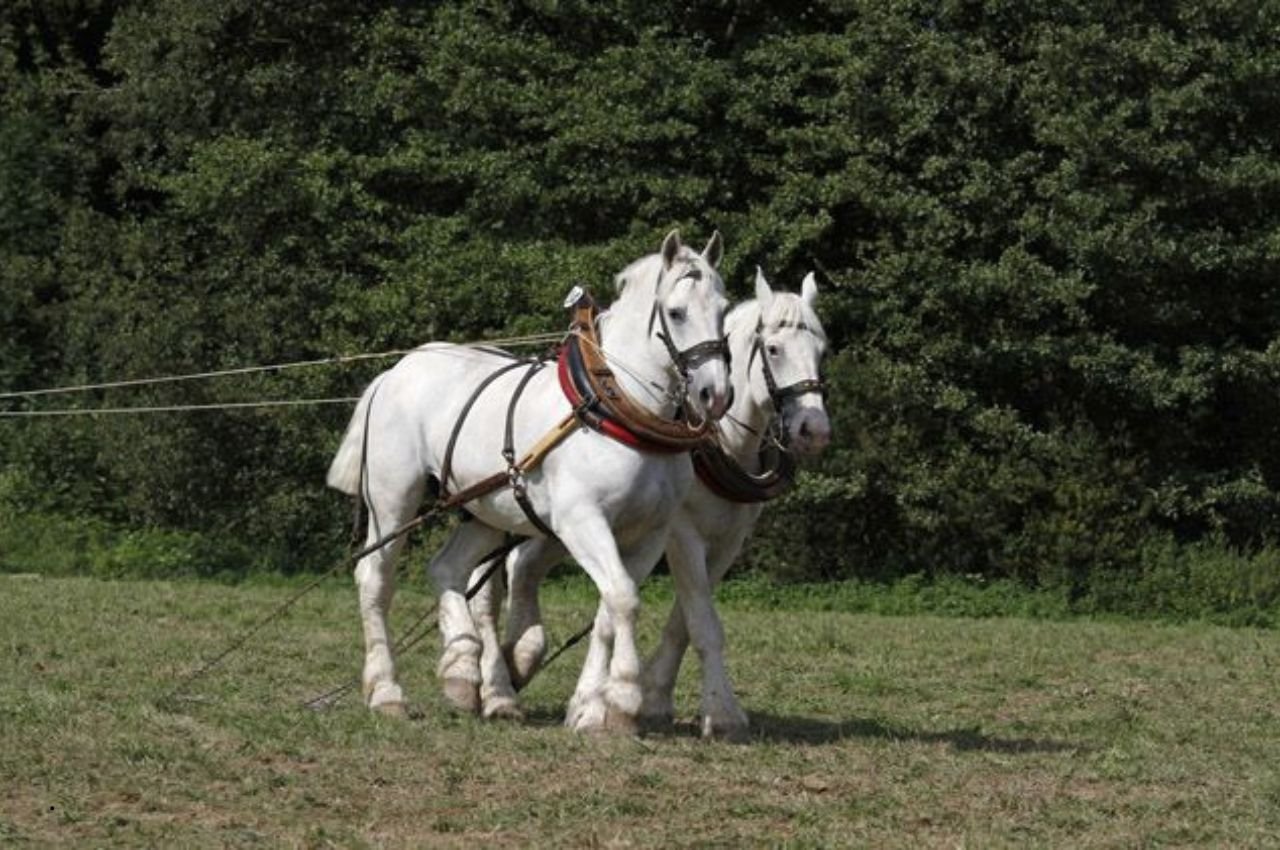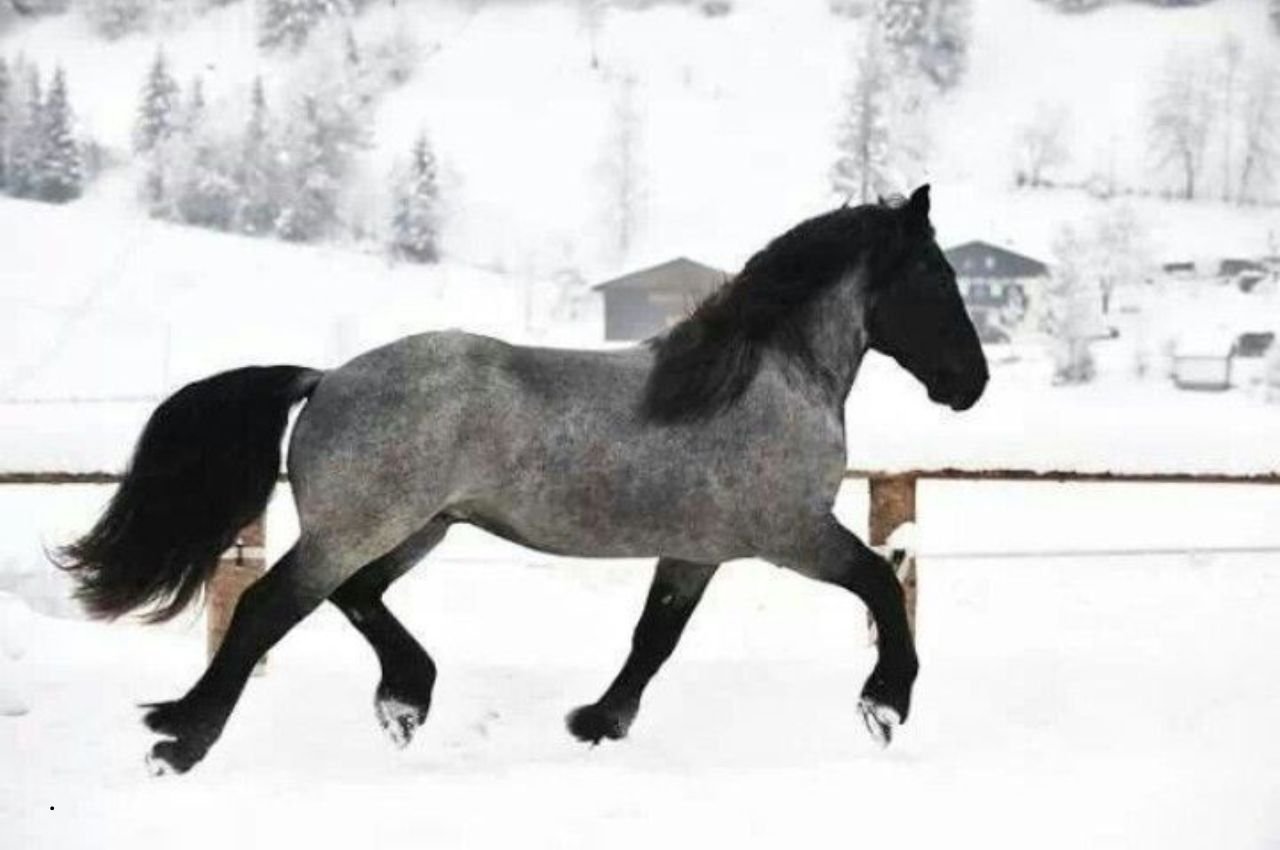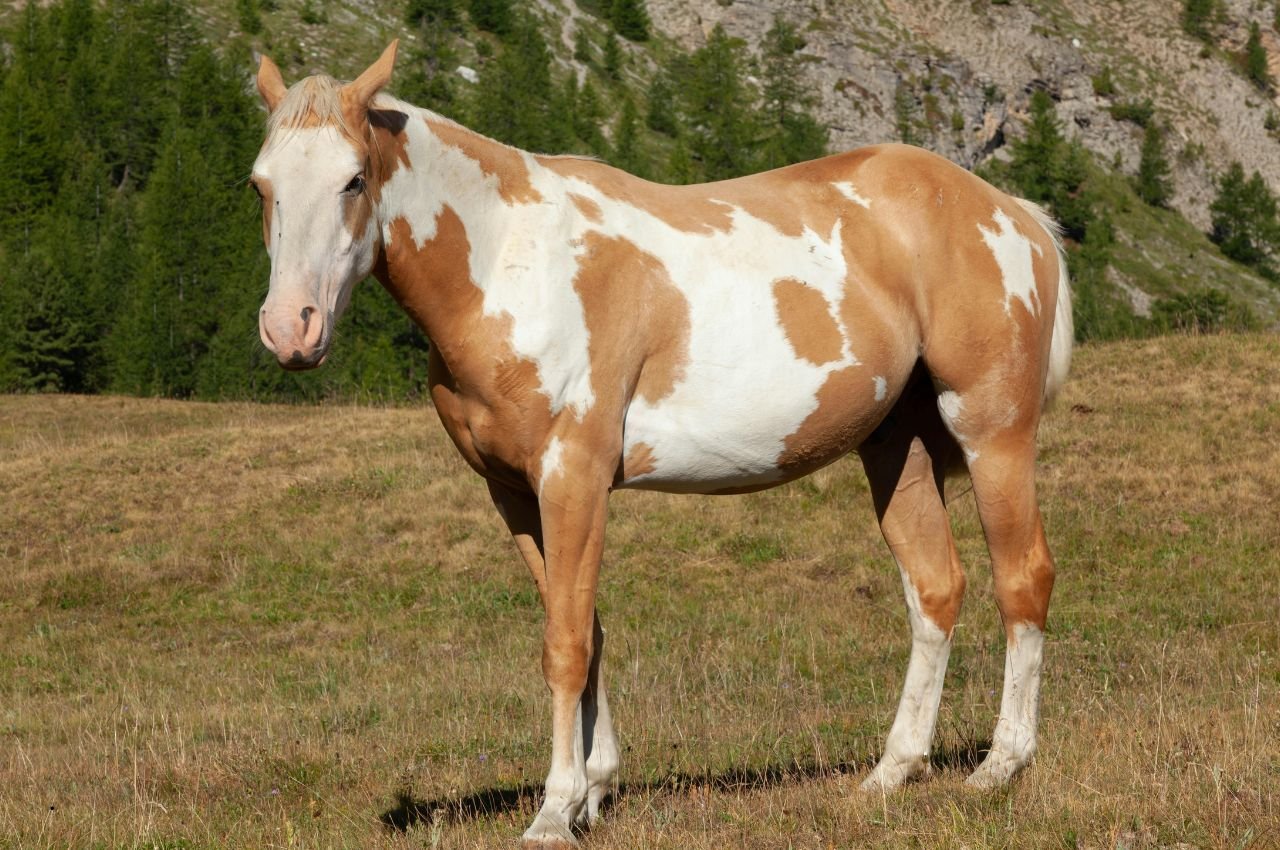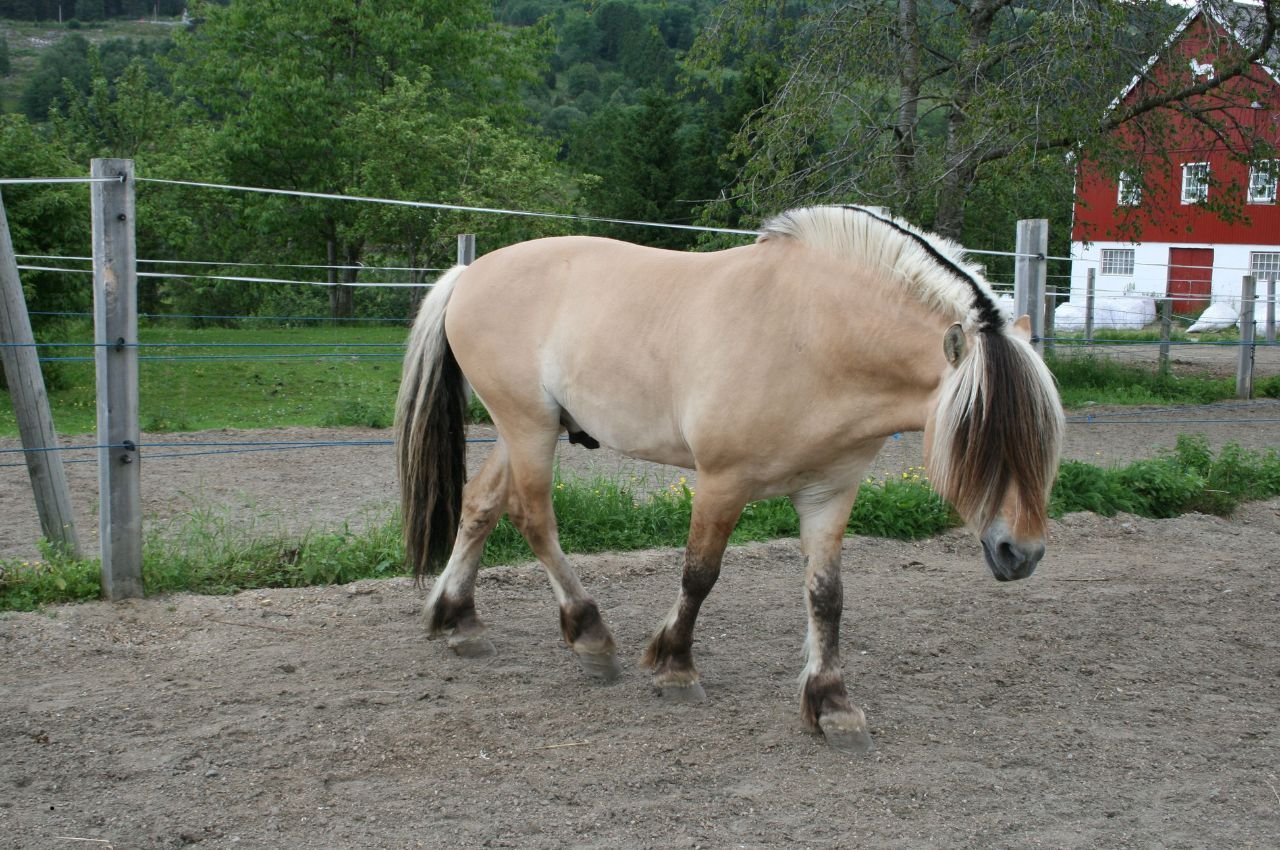The Vladimir Heavy Draft Horse stands as a testament to Russian equine breeding excellence, representing one of the most successful heavy horse development programs of the 20th century. Vladimir drafts combine ample size, stout build, speed and an energetic temperament, creating a unique blend of power and agility that sets them apart from other European draft breeds. The Vladimir is a draught horse of medium power, with energetic and active gaits. It is more solidly built than the Clydesdale, and unusually deep in the girth – thoracic circumference may reach 2.07 m.
What truly distinguishes the Vladimir Heavy Draft from other heavy draft horses is their exceptional combination of strength and speed – The Vladimir Heavy Draft is a Russian draft breed, that is known for its speed which is faster than the speed of most other heavy draft breeds. This remarkable balance of power and velocity makes them uniquely valuable for both traditional agricultural work and modern applications where efficiency and performance are paramount. They are known for their muscular build and calm temperament, and are often used as work horses in heavy agricultural duties.
Historical Development and Origins
The development of the Vladimir Heavy Draft represents one of the most systematic and scientifically approached horse breeding programs in equine history. The breed was developed during the first half of the 20th century, at breeding farms in Vladimir and Ivanovo regions, reflecting the Soviet Union’s commitment to developing specialized agricultural horses suited to Russian conditions and needs.
Early Foundation and Breeding Strategy
The Russian Empire had no indigenous breeds of heavy draught horse, making the development of the Vladimir Heavy Draft a necessity rather than mere agricultural improvement. The breed’s development began with a carefully planned crossbreeding program that utilized the best available European draft bloodlines while adapting them to Russian agricultural and climatic conditions.
First, native large Russian breeds were crossed with Percherons and Suffolk Punches. Then, the crossbred offspring were crossed with Clydesdales and Shires. This systematic approach reflected Soviet agricultural planners’ understanding that successful horse breeding required both scientific methodology and practical application to local conditions.
The breeding program’s success stemmed from its focus on creating horses that could meet the specific demands of Russian agriculture while possessing the strength and endurance necessary for the challenging working conditions found throughout the Soviet Union.
Clydesdale Influence and Development
The most important influence on the development of the breed was from three Clydesdale stallions foaled between 1910 and 1923. These influential sires provided the foundation for the breed’s distinctive characteristics, combining Clydesdale athleticism with Russian hardiness.
The Clydesdale influence contributed significantly to the Vladimir’s superior movement and energetic temperament, while the systematic breeding program ensured that these qualities were consistently passed to subsequent generations. This careful selection process created horses that retained the best characteristics of their foundation breeds while developing traits specifically suited to Russian conditions.
Official Recognition and Breed Establishment
Official recognition came in 1946, marking the culmination of decades of careful breeding and selection. This recognition represented not just administrative approval but acknowledgment that the breeding program had successfully created a distinct and valuable horse breed suited to Soviet agricultural needs.
Its experts invested no small effort in the creation of horses of uniform type in the region. In 1946 the new heavy draft breed was recognized. The breed’s official status ensured continued support for breeding programs and established standards that would maintain breed quality and consistency.
The Vladimir was created at about the same time as the development of the Russian Heavy Draught in Ukraine, demonstrating the comprehensive approach taken to developing specialized draft horses throughout the Soviet Union. This coordinated effort created complementary breeds that could serve different specialized functions within Soviet agriculture.
Physical Characteristics and Conformation
The Vladimir Heavy Draft presents a distinctive and impressive appearance that reflects its breeding for both power and agility. It is more solidly built than the Clydesdale, and unusually deep in the girth – thoracic circumference may reach 2.07 m, creating a profile that emphasizes substantial capacity for sustained work while maintaining athletic ability.
Size and Build Specifications
Vladimir Heavy Draft horses typically stand 16-17 hands high and weigh between 1,500-1,800 pounds, placing them in the medium to large category among draft horses. This size range provides the substantial build necessary for heavy work while maintaining the agility that distinguishes the breed from purely heavy draft types.
The breed’s conformation standards reflect careful balance between power and athleticism, with every aspect of their build contributing to their reputation for combining strength with speed. Their moderate size compared to giant draft breeds also contributes to their versatility and ease of management.
Head and Neck Structure
Small head. Convex profile. Straight ears characterize the Vladimir’s head conformation, reflecting their refined breeding and intelligent nature. The relatively small head in proportion to their substantial body demonstrates the breed’s efficiency and breeding for working ability rather than mere size.
The neck structure of Vladimir Heavy Draft horses provides the leverage necessary for maximum pulling efficiency while maintaining the flexibility required for athletic movement. This balance between power and mobility distinguishes them from purely heavy draft breeds and contributes to their superior working gaits.
Body and Limb Conformation
Strong, medium-ribbed body provides the structural foundation for the Vladimir’s working ability, with exceptional depth through the heart girth that supports sustained athletic effort. The thoracic development that can reach 2.07 meters in circumference provides space for large heart and lung capacity essential for endurance work.
It is usually clean-legged, though feathering can occur, distinguishing most Vladimir horses from heavily feathered breeds while allowing for some variation within breed standards. This clean-legged appearance reflects their development for working in varied terrain and weather conditions.
The limb structure shows substantial bone and muscular development appropriate for heavy work while maintaining the clean, athletic appearance that contributes to their speed and agility. Their feet are typically well-formed and proportionate to their body size, providing secure footing for various working conditions.
Movement and Athletic Ability
The Vladimir is a draught horse of medium power, with energetic and active gaits and The action is ample and energetic. This superior movement quality sets them apart from many draft breeds and contributes significantly to their working efficiency and versatility.
The breed’s movement reflects their Clydesdale heritage combined with selective breeding for athletic ability. Their gaits are not only powerful but also ground-covering and efficient, allowing them to maintain productive work rates over extended periods.
Temperament and Behavioral Characteristics
The Vladimir Heavy Draft exhibits a temperament that perfectly complements their physical capabilities, combining the strength necessary for heavy work with the intelligence and tractability required for effective cooperation with handlers. Good-tempered, quiet, and easy to handle, these horses are powerful, very vigorous and energetic.
Mental and Emotional Traits
Vladimir drafts combine ample size, stout build, speed and an energetic temperament, creating horses that approach work with enthusiasm while remaining manageable and safe to handle. This combination of energy and tractability makes them particularly valuable for operations requiring both power and precision.
The breed’s intelligence manifests in their ability to learn complex tasks quickly and work cooperatively with handlers. Their cognitive ability allows them to adapt to varying work requirements and respond appropriately to changing conditions, making them valuable partners rather than merely powerful machines.
Work Ethic and Cooperation
Vladimir Heavy Draft horses demonstrate exceptional work ethic that stems from generations of selection for horses willing to give sustained effort under challenging conditions. Their energetic temperament translates into eager participation in work activities rather than resistance or reluctance.
Their cooperative nature makes them particularly suitable for teamwork, both with other horses and with human handlers. This cooperation is essential for the complex coordination required in agricultural operations and other applications where horses must respond to subtle cues while managing substantial workloads.
Adaptability and Learning Ability
Modern Vladimir Heavy Draft horses demonstrate remarkable adaptability to various roles and environments. While they excel in their traditional roles as farm horses and logging horses, they have also found success in competitive driving, recreational applications, and educational programs.
Their learning ability extends beyond simple task training to include development of judgment and initiative that experienced working horses display. Mature Vladimir horses often anticipate work requirements and adapt their behavior to optimize efficiency and safety, demonstrating the intelligence that makes them valuable long-term partners.
Strength and Performance Capabilities
The Vladimir Heavy Draft’s reputation for exceptional strength and performance capability stems from their unique combination of substantial build and athletic movement. While the Vladimir is considered to be a heavy draft, it is lighter than most other drafts that belong to this group, and has less pulling power. The greatest asset of this draft is their speed and agility combined with respectable pulling capacity.
Power Output and Work Capacity
Vladimir Heavy Draft horses excel in applications requiring sustained power delivery rather than maximum pulling force. Their pulling capacity is substantial but their true value lies in their ability to maintain consistent work output over extended periods while moving at faster speeds than traditional heavy draft breeds.
The breed’s power characteristics make them particularly valuable for work requiring mobility and endurance rather than just brute strength. This suits them ideally for modern agricultural applications where efficiency and productivity are more important than maximum pulling capacity.
Speed and Agility Advantages
The Vladimir Heavy Draft is a Russian draft breed, that is known for its speed which is faster than the speed of most other heavy draft breeds. This superior speed capability sets them apart from other draft breeds and creates unique opportunities for specialized applications.
The combination of speed and substantial build makes Vladimir horses particularly valuable for work requiring rapid transportation of heavy loads or operations where time efficiency is crucial. Their energetic gaits allow them to cover ground quickly while maintaining pulling capacity.
Endurance and Stamina
The endurance capabilities of Vladimir Heavy Draft horses reflect both their substantial build and their efficient movement patterns. Their ability to maintain productive output over extended working periods makes them particularly valuable for sustained agricultural operations and commercial applications.
This endurance extends beyond purely physical capabilities to include the mental stamina necessary for complex, demanding work. Vladimir horses typically maintain focus and cooperation throughout long working days, demonstrating the psychological durability that complements their physical capabilities.
Versatility in Applications
Even though it is a working equine breed, its agility along with a stout build makes it suitable for use in riding and dressage. This versatility demonstrates the breed’s balanced development and creates opportunities for diverse applications beyond traditional draft work.
The breed’s combination of strength, speed, and trainability makes them suitable for competitive driving, recreational activities, and specialized applications where both power and agility are required.
Health Considerations and Management
Vladimir Heavy Draft horses generally exhibit robust health and hardiness, but their substantial size and athletic demands create specific health management requirements. Understanding these considerations is essential for maintaining optimal health and performance throughout their working lives.
General Health Strengths and Characteristics
The breed’s development in challenging Russian conditions has created horses with natural hardiness and disease resistance. Their robust constitution generally supports good health when basic management requirements are met, though their size and athletic use create specific monitoring needs.
Vladimir horses typically enjoy good longevity when properly managed, often remaining productive well into their late teens or early twenties. Their efficient metabolism and strong constitution contribute to overall wellness when appropriate care is provided.
Common Health Considerations
Vladimir horses include joint problems, colic, and lameness. It is essential to provide them with proper nutrition and veterinary care to maintain their health and wellbeing. These issues, while not unique to the breed, require attention due to their size and working demands.
Joint health monitoring becomes particularly important for working Vladimir horses, as their athletic demands and substantial size place additional stress on supporting structures. Regular assessment helps identify developing problems before they become performance-limiting.
Digestive health requires attention to prevent colic and other gastrointestinal issues common in large horses. Proper feeding management and consistent access to quality feed and water help maintain digestive wellness.
Preventive Health Care Programs
Comprehensive preventive health care should address both standard equine health needs and the specific requirements of large, athletic horses. Regular veterinary examinations help identify potential problems before they impact performance or welfare.
Vaccination programs should be tailored to local disease risks while following core vaccination recommendations. The breed’s generally robust immune system responds well to standard vaccination protocols when properly administered and scheduled.
Dental care requires attention to the larger teeth and stronger jaw muscles of draft horses, with regular examinations ensuring proper feed utilization and comfort during work activities.
Exercise and Conditioning Management
Working Vladimir Heavy Draft horses require systematic conditioning programs that gradually prepare them for their intended work while monitoring for signs of overexertion or developing problems. Their willing nature means they may work beyond their fitness level if not properly conditioned.
Exercise management should provide adequate physical activity to maintain muscle tone, cardiovascular health, and mental well-being while preventing the problems associated with either inactivity or overuse in large horses.
Nutritional Requirements and Feeding Management
Proper nutrition forms the foundation for maintaining Vladimir Heavy Draft horses in optimal condition for both work and health. Their substantial size and athletic demands create specific feeding requirements that must be carefully managed to support performance while preventing nutrition-related problems.
Basic Energy and Forage Requirements
Vladimir Heavy Drafts require a well-balanced diet to support their large size and strength. Their feeding regimen typically consists of high-quality hay, supplemented with grains such as oats or barley for added energy. Like other large horses, they typically require 2-3% of their body weight in total feed daily, with the majority coming from quality forage sources.
For a typical Vladimir Heavy Draft weighing 1,600 pounds, daily feed requirements range from 32-48 pounds total, with at least 24-32 pounds coming from hay or pasture. A typical horse should consume 2% of their body weight in forage daily. This means that draft horses need significantly more hay on a daily basis than lighter breeds.
Energy Requirements for Athletic Performance
Working Vladimir Heavy Draft horses require additional energy beyond maintenance levels to support their athletic demands. For adult horses of the heavy Vladimir breed, oats (bucket), 15-18 kilograms of hay, bran – up to 2 kilograms, carrots – 5 need to be prepared and given daily, providing specific guidelines for daily feeding management.
The breed’s reputation for speed and athleticism means their energy requirements may be higher than traditional heavy draft breeds during periods of intensive work. High-energy feeds like oats and quality hay help support their performance capabilities.
Protein and Growth Considerations
Growing Vladimir Heavy Draft horses require adequate protein to support their substantial development while maintaining proper growth rates. Protein requirements typically range from 14-16% for young horses to 10-12% for mature horses, depending on work level and body condition.
Quality protein sources like alfalfa hay, legume pastures, or commercial protein supplements help ensure adequate amino acid profiles for optimal development and maintenance of muscle mass in working horses.
Mineral and Vitamin Supplementation
The substantial size and athletic demands of Vladimir Heavy Draft horses create increased requirements for minerals and vitamins compared to lighter breeds. Calcium and phosphorus balance becomes particularly important for supporting bone development and maintenance in large, active horses.
The diet of thoroughbred horses should contain fruits and vegetables, indicating the value of varied nutrition sources. Trace mineral supplementation should address potential deficiencies while supporting increased metabolic demands.
Water Requirements and Hydration Management
It’s crucial to provide ample fresh water at all times, along with access to clean, fresh water sources. Large, active horses like Vladimir Heavy Drafts typically consume 35-50 gallons of water daily, with requirements increasing during hot weather or intensive work periods.
Automatic waterers or large water tanks help ensure adequate intake while reducing labor requirements. Water quality monitoring ensures that water sources remain clean and palatable.
Feeding Management Strategies
Multiple daily feedings help optimize digestion and prevent problems associated with large single meals. Dividing the daily ration into 2-3 feedings supports digestive health while maintaining consistent energy availability.
Body condition monitoring helps ensure feeding programs maintain optimal weight while preventing obesity or undernourishment. Regular assessment allows for feeding adjustments based on work demands, seasonal changes, and individual needs.
Management and Housing Requirements
Successful management of Vladimir Heavy Draft horses requires understanding their specific needs as large, athletic horses while providing appropriate facilities and care routines. Their substantial size and energetic temperament create unique management considerations that must be addressed for optimal health and performance.
Housing and Shelter Systems
Vladimir Heavy Draft horses adapt well to various housing systems, from simple run-in shelters to elaborate barn facilities. Their Russian heritage provides natural hardiness, though working horses benefit from protection that allows recovery from demanding work.
Stall dimensions should accommodate their substantial size, typically requiring stalls of at least 12′ x 14′ with 14′ x 14′ or larger being preferable for comfort and safety. Ceiling height and door dimensions must also accommodate their size and athletic movement.
The breed’s energetic temperament may require exercise areas and management practices that provide adequate mental and physical stimulation. Turnout facilities should offer adequate space for movement and social interaction.
Pasture Management and Fencing
Pasture requirements for Vladimir Heavy Draft horses typically range from 2-3 acres per horse for adequate forage and exercise space. Their size and activity level mean they require substantial grazing areas to meet nutritional needs through pasture intake.
Fencing systems must safely contain large, athletic horses while providing visibility and safety. Board fencing, post and rail systems, and properly installed high-tensile wire work well when constructed to appropriate specifications.
Pasture rotation helps maintain grass quality while preventing overuse by large horses. The breed’s athletic nature means they may be harder on pastures than less active horses, requiring careful management to maintain forage quality.
Daily Care and Grooming Requirements
Vladimir Heavy Draft horses require standard equine grooming routines adapted for their size and coat characteristics. It is usually clean-legged, though feathering can occur, making daily leg care relatively straightforward compared to heavily feathered breeds.
Regular hoof care becomes particularly important for large, active horses, as proper trimming and shoeing help distribute substantial weight loads while supporting athletic performance. Professional farrier services experienced with draft horses are essential.
Their dense coat may require additional attention during shedding seasons, with consistent grooming helping manage the substantial amount of hair that large horses produce. Coat management practices should support natural weather protection while maintaining cleanliness.
Exercise and Activity Management
Vladimir Heavy Draft horses benefit from regular exercise programs that maintain their athletic conditioning and mental well-being. Horses not actively engaged in work should receive daily exercise to prevent problems associated with inactivity in large, energetic horses.
Conditioning protocols for working horses should gradually prepare them for intended tasks while monitoring fitness levels and preventing overexertion. Their willing nature requires careful management to prevent overwork during conditioning phases.
Climate and Environmental Considerations
The breed’s Russian heritage provides natural cold weather tolerance, though working horses or those in intensive management may benefit from blanket systems during severe weather to maintain body condition and reduce energy expenditure.
Heat management becomes more challenging for large horses engaged in athletic work, requiring adequate shade, ventilation, and cooling opportunities to prevent heat stress during demanding work periods.
Training and Work Applications
The Vladimir Heavy Draft’s combination of intelligence, strength, and energetic temperament makes them exceptionally versatile training candidates. Their heritage as working horses provides inherent understanding of cooperation and teamwork, while their athletic ability creates opportunities for diverse applications beyond traditional draft work.
Foundation Training Principles
Ground training forms the essential foundation for all Vladimir Heavy Draft training programs. Their energetic temperament and substantial size require handlers to establish clear communication and respect from the beginning of the training process.
Basic handling skills including leading, tying, grooming, and hoof care must be thoroughly established before advancing to more complex training. The breed’s intelligence typically makes foundation training straightforward, though their energy requires consistent, patient instruction.
Respect training takes on particular importance with energetic draft horses, as their combination of size and enthusiasm can become dangerous if not properly channeled. Establishing appropriate boundaries while maintaining their cooperative spirit requires skilled handling.
Traditional Draft Work Training
Draft training remains highly relevant for Vladimir Heavy Draft horses, whether intended for agricultural work, forestry operations, or commercial applications. The systematic progression from ground driving to full harness work allows horses to develop conditioning and understanding gradually.
Harness training should progress systematically, with particular attention to proper harness fitting for the breed’s athletic build. Vladimir horses typically adapt quickly to harness work, though their energetic nature requires careful attention to conditioning and workload management.
Team training takes advantage of the breed’s cooperative nature and intelligence, allowing them to develop the precise coordination required for effective teamwork in agricultural and commercial applications.
Athletic and Competitive Training
Even though it is a working equine breed, its agility along with a stout build makes it suitable for use in riding and dressage. This versatility creates unique training opportunities that showcase the breed’s athletic capabilities.
Competitive driving training allows Vladimir horses to demonstrate their speed and agility advantages while competing against other draft breeds. Combined driving competitions particularly suit their athletic abilities.
Performance training can develop their natural athleticism for specialized applications requiring both power and agility. Their energetic temperament and trainability make them excellent candidates for advanced training programs.
Modern Application Training
Sustainable farming applications benefit from the breed’s speed and efficiency advantages, making them valuable for operations where productivity and environmental sensitivity are important considerations.
Educational program training prepares Vladimir horses for roles in agricultural education and demonstration programs. Their impressive appearance and athletic ability make them excellent ambassadors for working horses.
Recreational training develops their potential for pleasure driving and trail activities, taking advantage of their versatility and cooperative temperament.
Modern Uses and Applications
Contemporary applications for Vladimir Heavy Draft horses span traditional agricultural work, specialized performance applications, and emerging roles in sustainable agriculture and heritage preservation. Their unique combination of strength, speed, and athleticism creates opportunities for diverse modern uses.
Agricultural and Farming Applications
Modern sustainable farming operations increasingly value the Vladimir’s combination of power and efficiency. Their speed advantage over traditional draft breeds makes them particularly valuable for operations where productivity and time efficiency are crucial considerations.
Market gardening applications benefit from their agility and precise control, allowing for cultivation work in confined spaces and around valuable crops. Their energetic movement helps cover more ground efficiently than slower draft breeds.
Organic farming systems value their ability to provide power without soil compaction or chemical inputs, while their efficiency helps reduce operational costs compared to purely heavy draft breeds.
Forestry and Land Management
Selective logging operations benefit from the Vladimir’s combination of pulling power and mobility, allowing them to extract timber while navigating forest terrain more efficiently than slower, heavier breeds.
Land management projects utilize their athletic ability for tasks requiring both power and precision, such as habitat restoration and conservation work.
Commercial and Performance Applications
Commercial driving operations value their impressive appearance and athletic ability for carriage services and tourism applications. Their speed and stamina advantages suit them well for extended driving activities.
Competitive sports showcase the breed’s athletic capabilities, with pulling competitions and driving events providing venues for demonstrating their performance capabilities.
Educational and Cultural Applications
Living history programs utilize Vladimir horses to demonstrate traditional farming methods while showcasing Russian agricultural heritage. Their historical significance and impressive capabilities make them excellent educational ambassadors.
University programs incorporate Vladimir horses in agricultural education and equine studies, providing hands-on experience with versatile working horses.
Therapeutic applications may benefit from their calm temperament combined with impressive presence, though their size requires specialized facilities and experienced handlers.
Conservation and Breeding Programs
Breed conservation efforts work to maintain genetic diversity while preserving the characteristics that make Vladimir horses unique among draft breeds. International breeding programs help ensure breed survival outside Russia.
Genetic preservation programs utilize modern technologies to maintain breed integrity while adapting to different management systems and climatic conditions worldwide.
Frequently Asked Questions (FAQs)
General Breed Information
Q: What makes Vladimir Heavy Draft horses different from other Russian draft breeds? A: The Vladimir Heavy Draft is a Russian draft breed, that is known for its speed which is faster than the speed of most other heavy draft breeds. Unlike the Soviet Heavy Draft (derived from Belgian Brabant) or Russian Heavy Draft (derived from Ardennais), the Vladimir was derived principally from the Clydesdale, giving them superior speed and agility.
Q: When were Vladimir Heavy Draft horses officially recognized? A: Official recognition came in 1946, after decades of systematic breeding in the Vladimir and Ivanovo regions. The most important influence on the development of the breed was from three Clydesdale stallions foaled between 1910 and 1923.
Q: How large are Vladimir Heavy Draft horses? A: Vladimir Heavy Draft horses typically stand 16-17 hands high and weigh 1,500-1,800 pounds. It is more solidly built than the Clydesdale, and unusually deep in the girth – thoracic circumference may reach 2.07 m.
Q: What is the temperament of Vladimir Heavy Draft horses? A: Good-tempered, quiet, and easy to handle, these horses are powerful, very vigorous and energetic. They combine ample size, stout build, speed and an energetic temperament with cooperative handling characteristics.
Physical Characteristics and Abilities
Q: Are Vladimir Heavy Draft horses as strong as other draft breeds? A: While the Vladimir is considered to be a heavy draft, it is lighter than most other drafts that belong to this group, and has less pulling power. However, the greatest asset of this draft is their speed and agility combined with respectable pulling capacity, making them more efficient for many applications.
Q: What colors do Vladimir Heavy Draft horses come in? A: Vladimir horses typically appear in bay, brown, chestnut, and black colors, with some displaying white markings on the face and legs. It is usually clean-legged, though feathering can occur, giving them a cleaner appearance than heavily feathered breeds.
Q: How fast can Vladimir Heavy Draft horses move? A: The Vladimir is a draught horse of medium power, with energetic and active gaits. The action is ample and energetic, allowing them to work at faster speeds than traditional heavy draft breeds while maintaining substantial pulling power.
Q: Can Vladimir Heavy Draft horses be ridden as well as driven? A: Yes, even though it is a working equine breed, its agility along with a stout build makes it suitable for use in riding and dressage. Their athletic ability and cooperative temperament make them versatile for various disciplines.
Care and Management
Q: What housing requirements do Vladimir Heavy Draft horses have? A: They require substantial housing accommodations with stalls of at least 12′ x 14′, preferably larger. Their energetic temperament benefits from adequate turnout facilities and exercise opportunities.
Q: How much pasture do Vladimir Heavy Draft horses need? A: Typically 2-3 acres per horse for adequate forage and exercise space due to their size and activity level. Pasture management should account for their athletic nature and potential impact on grass quality.
Q: Do Vladimir Heavy Draft horses require special equipment? A: Yes, their substantial size requires draft-sized equipment including larger halters, bridles, blankets, and harness. Their athletic build may require equipment designed for more active horses compared to purely heavy draft types.
Q: How do Vladimir Heavy Draft horses handle different climates? A: Their Russian heritage provides excellent cold weather tolerance, though they may need additional heat management in warmer climates due to their size and athletic nature.
Feeding and Nutrition
Q: How much do Vladimir Heavy Draft horses eat per day? A: For adult horses of the heavy Vladimir breed, oats (bucket), 15-18 kilograms of hay, bran – up to 2 kilograms, carrots – 5 need to be prepared and given daily. This typically equals 32-48 pounds of total feed daily for a 1,600-pound horse.
Q: Do Vladimir Heavy Draft horses have special nutritional needs? A: Vladimir Heavy Drafts require a well-balanced diet to support their large size and strength. Their athletic demands may require higher energy intake than traditional heavy draft breeds during periods of intensive work.
Q: What type of hay is best for Vladimir Heavy Draft horses? A: High-quality hay forms the foundation of their diet, with timothy hay, orchard grass, and mixed grass hays providing excellent nutrition. Legume hays can supplement protein needs.
Q: How much water do Vladimir Heavy Draft horses need? A: It’s crucial to provide ample fresh water at all times – typically 35-50 gallons daily, with requirements increasing during hot weather or intensive work periods. Clean water access is essential for health and performance.
Health and Veterinary Care
Q: What health issues are common in Vladimir Heavy Draft horses? A: Vladimir horses include joint problems, colic, and lameness as potential health concerns. Their size and athletic demands require attention to joint health and digestive wellness.
Q: How long do Vladimir Heavy Draft horses typically live? A: With proper care, Vladimir Heavy Draft horses often remain productive well into their late teens or early twenties. Their robust constitution generally supports good longevity when appropriate health management is provided.
Q: Do Vladimir Heavy Draft horses need special veterinary care? A: They benefit from veterinarians experienced with large, athletic horses. Regular preventive care including vaccinations, dental care, and joint monitoring is essential for maintaining health and performance.
Q: Are Vladimir Heavy Draft horses prone to any specific conditions? A: Like other large horses, they may be susceptible to issues related to their size and athletic use, but they generally exhibit robust health when provided with proper nutrition and veterinary care.
Training and Work
Q: Are Vladimir Heavy Draft horses easy to train? A: Yes, their intelligence and cooperative nature generally make training straightforward, though their energetic temperament requires consistent handling and clear communication from experienced handlers.
Q: What type of work are Vladimir Heavy Draft horses best suited for? A: They excel in applications requiring combination of strength and speed, including sustainable farming, forestry work, competitive driving, and commercial applications where efficiency is important.
Q: Can Vladimir Heavy Draft horses compete in driving events? A: Absolutely! Their speed and athletic ability make them excellent candidates for competitive driving and combined driving events, where they can demonstrate their unique capabilities.
Q: How do Vladimir Heavy Draft horses compare to other breeds for riding? A: While primarily bred for draft work, their agility and cooperative temperament make them suitable for riding applications, though their substantial size requires experienced riders and appropriate equipment.
Breeding and Availability
Q: Where can I find Vladimir Heavy Draft horses? A: Vladimir Heavy Draft horses are primarily found in Russia and former Soviet republics, with limited numbers available elsewhere. Contact international breed registries or draft horse organizations for availability information.
Q: Are Vladimir Heavy Draft horses expensive to purchase? A: Pricing varies based on training, age, bloodlines, and location, but as a specialized breed with limited availability outside Russia, they typically command premium prices compared to more common draft breeds.
Q: What should I look for when buying a Vladimir Heavy Draft horse? A: Evaluate conformation, movement quality, temperament, and health status. Look for the breed’s characteristic energetic gaits and cooperative temperament, while ensuring proper health screening and documentation.
Q: Are there breed registries for Vladimir Heavy Draft horses? A: Yes, breed registries maintain pedigree records and breed standards, though most are based in Russia. International registration may be available through specialized organizations.
Breeding and Genetics
Understanding the genetic principles and breeding practices that shaped the Vladimir Heavy Draft is essential for anyone involved in breed preservation or breeding programs. The breed’s systematic development provides valuable lessons about creating specialized horses through scientific breeding methods.
Genetic Foundation and Development
The Vladimir Heavy Draft’s genetic foundation reflects one of the most systematic breeding approaches in draft horse development. First, native large Russian breeds were crossed with Percherons and Suffolk Punches. Then, the crossbred offspring were crossed with Clydesdales and Shires, creating a carefully planned genetic combination.
The most important influence on the development of the breed was from three Clydesdale stallions foaled between 1910 and 1923, demonstrating how influential individuals can shape entire breeds when used systematically in breeding programs.
Modern genetic testing technologies allow contemporary breeders to understand genetic relationships and make informed breeding decisions while maintaining the characteristics that make Vladimir horses unique among draft breeds.
Breeding Objectives and Selection Criteria
Contemporary Vladimir breeding programs focus on maintaining the breed’s unique combination of strength, speed, and cooperative temperament. Key selection criteria include conformation that supports athletic ability, movement quality that demonstrates their speed advantage, and the energetic yet tractable temperament that defines the breed.
Performance evaluation helps assess working ability and athletic capability, providing objective measures for breeding decisions. The breed’s speed and agility advantages must be preserved while maintaining sufficient strength for draft applications.
Traditional traits like pulling capacity, endurance, and cooperative temperament remain important selection factors, balanced with the athletic ability that distinguishes Vladimir horses from purely heavy draft breeds.
Reproductive Management
Successful Vladimir breeding programs require careful attention to reproductive management that supports the breed’s athletic characteristics. Mare management includes optimizing nutrition for both reproductive success and maintaining the fitness necessary for breeding stock evaluation.
Stallion management must balance breeding activities with the performance evaluation necessary to assess genetic merit. The breed’s energetic temperament may require specialized handling during breeding activities.
Foal development programs should support the rapid growth and athletic development characteristic of Vladimir horses while preventing developmental problems that might impact their working ability.
International Breeding Programs
Conservation efforts outside Russia work to maintain Vladimir characteristics while adapting to different management systems and climatic conditions. International cooperation helps preserve genetic diversity while expanding the breed’s geographic distribution.
Genetic preservation programs utilize modern reproductive technologies to maintain breed integrity while preventing genetic bottlenecks in small populations outside the breed’s native range.
Conservation Status and Future Prospects
The Vladimir Heavy Draft’s future depends on continued appreciation for their unique combination of characteristics and ongoing efforts to maintain breeding programs that preserve their distinctive traits while adapting to modern needs and applications.
Current Population and Distribution
Vladimir Heavy Draft horses remain primarily concentrated in Russia and former Soviet republics, with limited populations established elsewhere. The breed’s specialized characteristics and relatively recent development mean they have not achieved the widespread international distribution of some older draft breeds.
Population monitoring helps track breeding success and genetic diversity within available populations, ensuring that conservation efforts can address potential challenges before they become critical.
The breed’s continued use in specialized applications helps maintain breeding incentives while providing economic support for conservation efforts.
Conservation Challenges and Opportunities
The breed’s relatively recent development and specialized characteristics create both challenges and opportunities for conservation efforts. Their unique speed and agility advantages provide clear differentiation from other draft breeds, creating market opportunities that support conservation efforts.
Genetic management programs work to maintain the breed’s distinctive characteristics while preventing inbreeding in smaller populations outside Russia. International breeding cooperation helps maintain genetic diversity.
Growing interest in sustainable agriculture and alternative farming methods creates new opportunities for Vladimir horses, where their efficiency advantages provide clear benefits over traditional draft breeds.
Modern Applications and Market Development
The breed’s unique characteristics position them well for emerging applications in precision agriculture, sustainable forestry, and competitive driving, where their speed and agility advantages provide clear benefits.
Educational applications help demonstrate the breed’s capabilities while supporting conservation through public awareness and appreciation. University programs provide research opportunities that support breed development.
Tourism applications capitalize on their impressive appearance and athletic ability while providing economic incentives for maintaining breeding programs.
Conclusion
The Vladimir Heavy Draft Horse represents one of the most successful examples of systematic horse breeding, combining scientific methodology with practical agricultural needs to create horses uniquely suited to their intended purpose. Their distinctive combination of Clydesdale athleticism with Russian hardiness has produced horses that excel in applications requiring both substantial strength and superior speed.
The breed’s development during the Soviet era demonstrates the potential for coordinated breeding programs to create specialized horses that serve specific agricultural and economic needs. While the Vladimir is considered to be a heavy draft, it is lighter than most other drafts that belong to this group, and has less pulling power, but their speed and efficiency advantages make them uniquely valuable for modern applications.
For those considering Vladimir Heavy Draft horses, whether for sustainable farming, competitive driving, or specialized applications, these remarkable horses offer a unique combination of power, athleticism, and cooperative temperament. Their energetic gaits and willing nature make them rewarding partners while their distinctive capabilities create opportunities for diverse applications.
The future of the Vladimir Heavy Draft depends on continued appreciation for their unique characteristics and ongoing efforts to maintain breeding programs that preserve their distinctive traits while adapting to contemporary needs. As interest in efficient farming methods, competitive equestrian sports, and heritage preservation continues to grow, the Vladimir Heavy Draft Horse is well-positioned to remain valuable and relevant for future generations.
With proper care, nutrition, and management, Vladimir Heavy Draft horses can serve as both productive working animals and athletic partners, embodying the successful combination of strength and speed that makes them unique among the world’s draft breeds.
References and Resources
For comprehensive breed information and characteristics, Oklahoma State University – Vladimir Heavy Draft provides detailed academic coverage of breed development and characteristics.
Historical development and breeding program information can be found through various Russian agricultural archives and Soviet breeding documentation that detail the systematic development process.
Contemporary breed management and applications are documented through international draft horse organizations that promote working horse use and breed preservation worldwide.
Scientific research on draft horse genetics and breeding is available through equine genetics laboratories that provide testing services and maintain databases of genetic information.
Professional feeding and nutrition guidance for athletic draft horses can be found through equine nutrition specialists who provide research-based recommendations for optimal performance and health.
Training and management resources are available through draft horse training organizations and working horse associations that promote traditional skills and modern applications.
Competitive driving information and opportunities can be found through driving sport organizations that sponsor events where Vladimir horses can demonstrate their athletic capabilities.
Educational programs and demonstration opportunities are available through agricultural education centers and living history organizations that showcase working horse applications.
This comprehensive guide provides general information about the Vladimir Heavy Draft Horse breed. Always consult with qualified veterinarians, equine nutritionists, experienced horsemen, and breed specialists for specific advice regarding individual horses, training programs, and management decisions.

